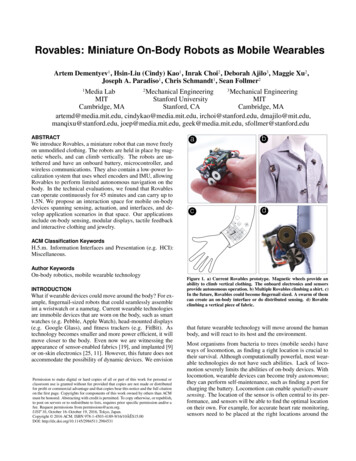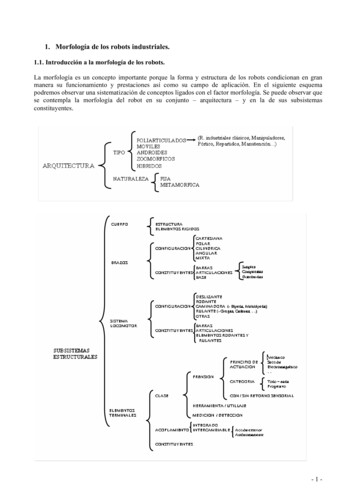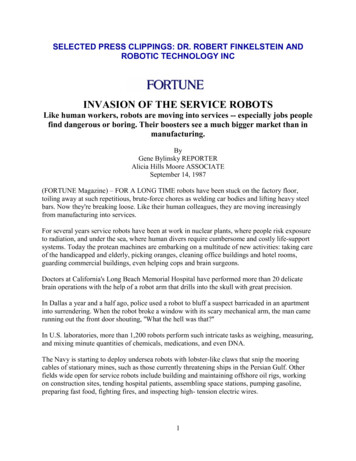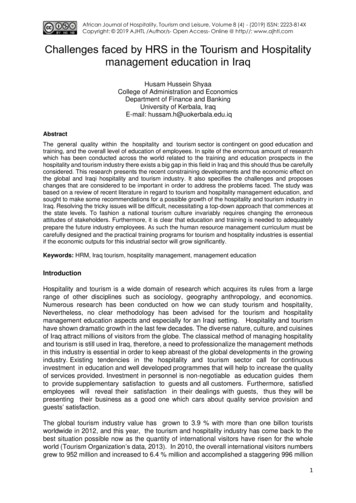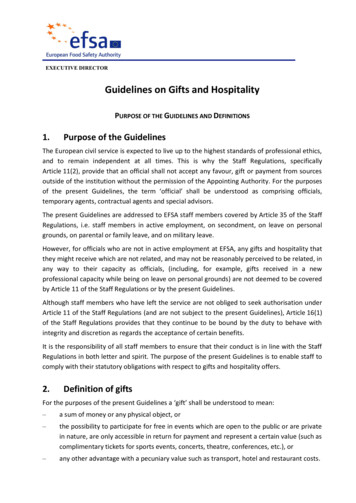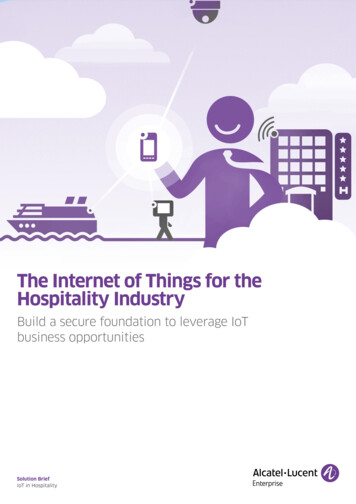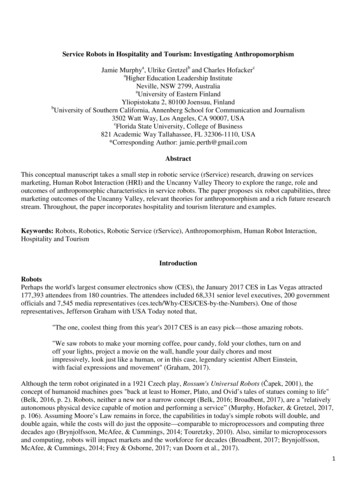
Transcription
Service Robots in Hospitality and Tourism: Investigating AnthropomorphismJamie Murphya, Ulrike Gretzelb and Charles HofackercaHigher Education Leadership InstituteNeville, NSW 2799, AustraliaaUniversity of Eastern FinlandYliopistokatu 2, 80100 Joensuu, FinlandbUniversity of Southern California, Annenberg School for Communication and Journalism3502 Watt Way, Los Angeles, CA 90007, USAcFlorida State University, College of Business821 Academic Way Tallahassee, FL 32306-1110, USA*Corresponding Author: jamie.perth@gmail.comAbstractThis conceptual manuscript takes a small step in robotic service (rService) research, drawing on servicesmarketing, Human Robot Interaction (HRI) and the Uncanny Valley Theory to explore the range, role andoutcomes of anthropomorphic characteristics in service robots. The paper proposes six robot capabilities, threemarketing outcomes of the Uncanny Valley, relevant theories for anthropomorphism and a rich future researchstream. Throughout, the paper incorporates hospitality and tourism literature and examples.Keywords: Robots, Robotics, Robotic Service (rService), Anthropomorphism, Human Robot Interaction,Hospitality and TourismIntroductionRobotsPerhaps the world's largest consumer electronics show (CES), the January 2017 CES in Las Vegas attracted177,393 attendees from 180 countries. The attendees included 68,331 senior level executives, 200 governmentofficials and 7,545 media representatives (ces.tech/Why-CES/CES-by-the-Numbers). One of thoserepresentatives, Jefferson Graham with USA Today noted that,"The one, coolest thing from this year's 2017 CES is an easy pick—those amazing robots."We saw robots to make your morning coffee, pour candy, fold your clothes, turn on andoff your lights, project a movie on the wall, handle your daily chores and mostimpressively, look just like a human, or in this case, legendary scientist Albert Einstein,with facial expressions and movement" (Graham, 2017).Although the term robot originated in a 1921 Czech play, Rossum's Universal Robots (Čapek, 2001), theconcept of humanoid machines goes "back at least to Homer, Plato, and Ovid’s tales of statues coming to life"(Belk, 2016, p. 2). Robots, neither a new nor a narrow concept (Belk, 2016; Broadbent, 2017), are a "relativelyautonomous physical device capable of motion and performing a service” (Murphy, Hofacker, & Gretzel, 2017,p. 106). Assuming Moore’s Law remains in force, the capabilities in today's simple robots will double, anddouble again, while the costs will do just the opposite—comparable to microprocessors and computing threedecades ago (Brynjolfsson, McAfee, & Cummings, 2014; Touretzky, 2010). Also, similar to microprocessorsand computing, robots will impact markets and the workforce for decades (Broadbent, 2017; Brynjolfsson,McAfee, & Cummings, 2014; Frey & Osborne, 2017; van Doorn et al., 2017).1
Robots generally fall into one of three categories—industrial, professional service and personal service (Thrun,2004; Vaussard et al., 2014). The capabilities and design of personal service robots, also known as companionor social robots, generated the CES buzz (Graham, 2017; Ackerman, 2017). Personal service robots, which havethe most autonomy and social interaction of the three robot categories, are the focus of this manuscript becausethey are particularly relevant for tourism and hospitality (Murphy, Hofacker, & Gretzel, 2017).Emerging hospitality and tourism robotic applications include waiters in southeast Asia, a robot-staffed hotel inJapan, a bellboy in the USA and industrial robots that clean or make drinks (Belk, 2016; Collins, 2015; Pan,Okada, Uchiyama, & Suzuki, 2015; van Doorn, et al., 2017). Academic literature noting that robots have leaptfrom science fiction into hospitality and tourism is gaining traction and often mentions Human RobotInteraction (HRI) as a key area to investigate (Andrews, 1984; Belk, 2016; Fan, Wu & Mattila, 2016; Pan, et al.,2015; van Doorn et al., 2017). A recent hospitality and tourism article proposes six robotic research areas:customer acceptance of robots, robotic design and robots' impact on the work environment, managementtraining, facility design and bottom line (Murphy, Hofacker, & Gretzel, 2017).HRI, a common theme across these six research areas and particularly with service robots, includescommunication—e.g., voice, haptic, visual and programming—and anthropomorphic features (Belk, 2016).Anthropomorphism—how robots look, move and communicate similar to humans—helps "predict the degree ofmoral care and concern afforded to an agent, the amount of responsibility and trust placed on an agent, and theextent to which an agent serves as a source of social influence on the self” (Waytz, Cacioppo, & Epley, 2014, p.1). Furthermore, the relationship between a robot's anthropomorphic features and emotional responses to thatrobot seem nonlinear (Belk, 2016; Broadbent, 2017; Mori, 1970). How anthropomorphic characteristics andcommunication relate to HRI and service robot success seems critical for tourism and hospitality enterprises andacademics.rServiceServices marketing's concern with technology diffusion and technology's customer impacts (see Kim, Wang, &Malthouse, 2015; S. Y. Lam & Shankar, 2014 for two recent examples) helps bridge HRI and service robotsresearch. Services scholars developed the eService paradigm—providing service over electronic networks (Rust& Kannan, 2003, p. 38)—and its impact on customers (e.g., Collier & Bienstock, 2006; Fassnacht & Koese,2006; Parasuraman, Zeithaml, & Malhotra, 2005). Almost all e-service studies, whether looking at innovationadoption or implementation, focus on software that runs on an inert device such as a desktop computer or amobile phone. To the authors' knowledge however, just two articles examine robotic service—rService—andboth draw on HRI (Pan, et al., 2015; van Doorn et al., 2017).An experimental study in Japan that tested hotel lobby robots as an alternative to information on digital signsfound that robot head movement and direct greetings worked best (Pan et al., 2015). The second article,introduced the concept of automated social presence (ASP), developed a typology of different automated andhuman social presence with customers and conceptualised relationships between ASP and key service andcustomer outcomes (van Doorn et al., 2017). The authors noted that a major limitation of their study wasignoring the Uncanny Valley theory (Broadbent, 2017; Belk, 2016; Mori, 1970; Mori, MacDorman, & Kageki,2012), which suggests a non-linear relationship between a robot's anthropomorphic features and emotionalresponses to that robot.Literature ReviewRobot Autonomy, Capabilities and DesignIn determining which theories might suit anthropomorphism, it is appropriate to consider autonomy, robotcapabilities and robot design. As these engineering achievements will condition the consumer or demand side2
of the robot story, it makes sense to understand what the consumer will encounter. Autonomy, critical to thenotion of a robot, helps distinguish among devices that make decisions with or without human input. Ratherthan a dichotomy, robot autonomy ranges from basic levels of manual teleoperation to full autonomy (Beer,Fisk, & Rogers, 2016).In addition to considering autonomy, the key robot capabilities in Table 1 below have two interpretations. First,robots vary in their capabilities; there are and will be many specialised robot types with different capabilities.Second, with the addition of each row robots become more adept and more capable (Brynjolfsson et al., 2014;Touretzky, 2010).Table 1. Proposed Robot CapabilitiesCapabilityExamplesGeneral MobilityStationary, Mobile, Swimming, FlyingTask MobilityLifting, Carrying, Pushing, OpeningCommunication: Robot-RobotSwarming, CoordinatingCommunication: Human-Robot Voice, Gestures, Touch, Emotions, Remote Control, SensorsCommunication: Robot-Human Voice, Gestures, Touch, Emotions, DisplaySociality: Human-RobotUnderstanding, Empathising, LearningSociality: Robot-HumanExplaining, Advising, Conveying AffectMemoryStoring, Retaining and Retrieving InformationSensory ProcessingSensing, Perceiving, IdentifyingSymbolic ProcessingUnderstanding, Thinking, ReasoningDesign relates to how robots move and interact. For example, robots' arm/leg-like sub-systems vary in thedegrees of freedom of translation and rotation (Kavic 2004), i.e. the degree of humanness. Robots also vary intheir surface composition. Designers may use plastic or metal, or create a skin-like look. Robots may also bemuch smaller or larger than human-scale. Many CES 2017 service robots tended to be short, white, round andsmooth, albeit one robot resembled Albert Einstein’s head (Ackerman, 2017; Graham, 2017).The Uncanny ValleyRobot autonomy, capabilities andanthropomorphic differences, as well asthe context and humans themselves, maylead to non-linear effects on humanresponses to robots. As Table 1 aboveillustrates, the ten robot capabilities implymany physical forms. Mobility, forexample, can be life-like (legged robots)and thus imitate a biological organism.Robots can also be wheeled or spherical(rolling ball robots) and imitate machineslike automobiles. This blurring of theliving and the mechanical gives robotstheir dominant perceptual characteristics.Since many robot capabilities characterise3
life, an important robot perception dimension is their degree of human likeness as in Figure 1, the UncannyValley (Broadbent, 2017; Belk, 2016; Mori, 1970; Mori, MacDorman, & Kageki, 2012). A popular theory, theUncanny Valley suggests that a robot’s degree of human likeness relates to feeling comfortable with the robot.Rather than a linear relationship, the feelings become eerie as the robots almost resemble humans—theUncanny Valley. The relation again becomes positive as the likeness becomes even more human. At least onestudy extends this Uncanny Valley to monkeys' visual behaviour towards monkey faces (Steckenfinger, &Ghazanfar, 2009).Uncanny valley research often draws on perceptual, cognitive, and social mechanisms and studies human faces.For example, manipulating computer generated human facial proportions, skin texture, and detail suggestedcomplex factors and interactions varying the level of eeriness (MacDorman, Green, Ho, & Koch, 2009). Assuggested in subjective ratings of robot video clips, there is no single Uncanny Valley for a particular range ofhuman likeness; appearance is just one of many factors influencing perceptions of a robot as strange, familiar oreerie (MacDorman, 2006).Other robotic factors include touch, movement, materials and speech (Mori, MacDorman, & Kageki, 2012; Pan,et al., 2015). For example, participants reacted favorably when a nursing robot touched them (Chen, King,Thomaz, & Kemp, 2014). The robot's perceived intent however, showed a more favourable response forcleaning participants’ arms than for comforting participants. Furthermore, a verbal warning decreased thefavourablity. And although not a robot per se, an experimental study tested the impact of a self-servicetechnology (SST) machine's voice on consumer intentions to switch to traditional interpersonal customerservice (Fan, Wu, & Mattila, 2016). A human-like rather than robotic voice led to lower switching intentions.The above SST study highlights the consumer's role in HRI, as theconsumer's sense of power and the presence of other customersattenuated the switching intentions for powerful customers (Fan,Wu, & Mattila, 2016). Similarly a type of technological readiness,using the Internet via a smartphone, showed a strong interactioneffect on human likeness and service robot adoption (Goudey &Bonin, 2016). In addition to human likeness, which can vary frommachine- to human-like, the study context and the study participantsthemselves can attenuate or amplify the effects of human likeness(Goudey & Bonin, 2016; Read & Belpaeme, 2014; Rosenthal-vonder Pütten, et al., 2013). Teasing out the Uncanny Valley is adifficult, complicated and ongoing quest (Belk, 2016; Broadbent,2017; van Doorn et al., 2017; Waytz, Cacioppo, & Epley, 2014).FindingsThe robotic continuum from machine- to human-like has marketingimplications. As noted, anthropomorphism can predict care, concern,responsibility and trust afforded by a robot and the robot's socialinfluence on the self (Waytz, Cacioppo, & Epley, 2014). Figure 2illustrates how the Uncanny Valley may translate into two importantmarketing outcomes. One is acceptance or trial, a standardinnovation adoption metric (Rogers, 2003). Human likeness would apriori be neutral with respect to robotic service delivery (van Doornet al., 2017). Yet a robot falling into the Uncanny Valley may neverbe adopted.4
Anthropomorphic LoyaltyThe top panel of Figure 2 shows the second outcome, a proposed new construct. Anthropomorphic loyaltymerges consumer loyalty to an inanimate brand, and the loyalty traditionally reserved for a human companion.Anthropomorphic loyalty comes into play when the robot is sufficiently human like.Such anthropomorphic loyalty seems a key outcome as service marketers have long shown various entities towhich a relationship, and hence loyalty, can attach. As Reynolds and Beatty (1999) posit, customer-firm andcustomer-salesperson relationships differ. Similar to the e-commerce sphere, the customer may develop loyaltyto the interface (Murry & Häubl, 2003). Finally, given the full force of anthropomorphism and how potent it canbe in practice (e. g., Moon 2003), that loyalty could attach to robots in much stronger ways than to other sourcesof digital interaction.Ownership ContextNumerous potential implementation issues revolve around robot ownership. Customer-owned robots thatfunction in the house and yard are becoming commonplace (Murphy, Hofacker & Gretzel, 2017); personalservice/companion/care/butler robots were popular at CES 2017 (Ackerman, 2017; Graham, 2017).Furthermore, robots could represent the customer to the firm, such as a physical rather than virtual shopbot(Kumar, Dixit, Javalgi, & Dass, 2016) or in a social role like chatbots. Firm-owned robots should surface inother contexts such as retailing, healthcare, hospitality, delivery and transport and manufacturing (B2B).Finally, psychological ownership helps consider the extent that "technology infusion provides customers with asense of control in service experiences, an ability to understand and express their self-identity, and a sense ofbelongingness, resulting in a desire to revisit the service experience in the future" (van Doorn et al., 2017, p.44).The intersection of psychological ownership and anthropomorphism provides an additional area of interest—potential consumer discomfort. While consumers have no problems owning objects, most individuals wouldreject the idea of owning people. Perhaps anthropomorphism relates positively with feelings of psychologicalownership and responsibility for robot actions.Anthropomorphism DimensionsThe literature review suggests that anthropomorphism goes beyond robot appearance and includes capabilities,autonomy and actions. An underexplored area is robot personality and interaction/communication modesnormally ascribed to humans (being embarrassed, spontaneous, funny, moody, flirty, etc.). Anthropomorphicmarketing literature (e.g. Veer, 2013) has shown that brands successfully use anthropomorphism to stimulateattachment. Current efforts to humanise brands via social media marketing could inform service robot design byidentifying what makes interactions engaging. Applying human-human interaction principles to human-machineinteractions (Reeves & Nass, 1996) seems applicable if the machines look, act and interact like humans. It istherefore essential to understand which dimensions and levels of anthropomorphism most likely trigger ahuman-interaction schema.ConclusionThat robots will evolve and alter both the workforce and marketplace is clear; unclear is the extent of thisevolution and alteration (Broadbent, 2017; Brynjolfsson, McAfee, & Cummings, 2014; Collins, 2015; Frey &Osborne, 2017; van Doorn et al., 2017). A central issue in this context is HRI. This paper conceptualisedanthropomorphism and ownership as critical factors influencing customer-robot service interactions. Whileexisting literature focuses on frequent/regular interactions, the tourism and hospitality field does usually notafford overcoming the Uncanny Valley through learning and habituation. It therefore is an important context inwhich to build knowledge on first impressions of robots and short-term interactions. To our knowledge, this isone of few studies that explores the intersection of robots with tourism and hospitality services.5
Research LimitsConceptualising HRI in tourism and hospitality settings is difficult; robots are a rare phenomenon in theseenvironments and existing HRI research is in very different service contexts. Empirical research is clearlyneeded to better understand the peculiarities of tourism and hospitality HRI. For instance, an important tourismand hospitality aspect not considered in this conceptualisation is intercultural interactions.Practical ImplicationsBy definition of autonomy, managing robotic products will be unlike managing most tangible goods, which donot exhibit agency. How robots interact with and are treated by other staff, other robots and customers is animportant area of consideration for future tourism and hospitality managers. Robot capabilities and appearancewill both be critical on the consumer side due to problems stemming from the Uncanny Valley. Another aspectto consider is how robots design can fit into, and elevate, the service culture that forms the core of many tourismand hospitality brands.Future ResearchA burgeoning research stream this century has applied SERVQUAL to electronic service quality, or eService(e.g., Fassnacht & Koese, 2006). The automated nature of websites and many email replies, however, rendersoffline service quality measures inappropriate for measuring eService (Parasuraman, Zeithaml, & Malhotra,2005), albeit studies extend SERVQUAL to websites and email (Murphy, Schegg & Olaru, 2007). ExtendingSERVQUAL to service robots merits research from two aspects, robots as an employee and as a self-servicetechnology. An complementary approach to SERVQUAL could compare service robots and humans on two keydimensions—affect and cognition—that drive marketing outcomes (Cronin, Brady, & Hult, 2000).Engagement, critical for HRI and ultimately customer service, is one of many dependent measures for futureresearch. A recent experimental study confirmed and provided evidence that classic HRI engagement modelsshould consider attitudes and personality traits (Ivaldi, et al., 2016). Extroversion related positively to talkingwith the robot and a negative attitude towards robots led to looking less at a robot's face and more at the robot'shands. Thus, future research needs to extend current customer engagement on social media literature to the HRIcontext, with emphasis not only on how to encourage/initiate and sustain engagement but also how toeffectively measure engagement quality and outcomes.At Uncanny Valley's far right, the android/gynoid (male/female) is a personal service robot that isanthropomorphic in both appearance and behaviour (Belk, 2016; Broadbent, 2017). Researching this end of thespectrum remains a challenge as the technological development has not advanced enough to create these kindsof robots. Future research could examine rService via androids, using scenarios and computer generated images.ReferencesAckerman, E. (2017). CES 2017: Why Every Social Robot at CES Looks Alike. Retrieved ikeAndrew, W. P. (1984). Hospitality Education and the Technological Revolution. Journal of Hospitality &Tourism Research, 8(2), 15-21.Beer, J. M., Fisk, A. D., & Rogers, W. A. (2012). Toward a Psychological Framework for Levels of RobotAutonomy in Human-Robot Interaction. Human Factors and Aging Laboratory Technical Reports.Atlanta, GA: Georgia Institute of Technology, School of Psychology – Human Factors and AgingLaboratory.Belk, R. (2016). Understanding the robot: Comments on Goudey and Bonnin (2016). Recherche et Applicationsen Marketing (English Edition), 31(4), 83-90.6
Broadbent, E. (2017). Interactions with Robots: The Truths We Reveal About Ourselves. Annual Review ofPsychology, 68(1), 627-652.Brynjolfsson, E., McAfee, A., & Cummings, J. (2014). The Second Machine Age: Work, Progress, andProsperity in a Time of Brilliant Technologies. New York, NY: W. W. Norton & Company.Čapek, K. (2001). Rossum s Universal Robots (P. Selver & N. Playfair, Trans.): Dover Publications.Chen, T. L., King, C. H. A., Thomaz, A. L., & Kemp, C. C. (2014). An investigation of responses to robotinitiated touch in a nursing context. International Journal of Social Robotics, 6(1), 141-161.Collier, J. E., & Bienstock, C.C. (2006). Measuring service quality in e-retailing. Journal of Service Research,8(3), 260-275. Retrieved from http://dx.doi.org/10.1177/1094670505278867Collins, G. (2015). The Rise of Robotics in Hospitality. HiTech 2015 Special Report, pp. 22-23.Cosmides, L., & Tooby, J. (2013). Evolutionary Psychology: New Perspectives on Cognition and Motivation.Annual Review of Psychology, 64, 201-229. Retrieved Cronin, J.J., Brady, M.K., & Hult, G.T.M. (2000). Assessing the Effects of Quality, Value, and CustomerSatisfaction on Consumer Behavioral Intentions in Service Environments. Journal of Retailing, 76 (2),193-218.Fan, A., Wu, L., & Mattila, A.S. (2016). Does anthropomorphism influence customers’ switching intentions inthe self-service technology failure context?. Journal of Services Marketing, 30(7), 713-723.Fassnacht, M., & Koese, I. (2006). Quality of electronic services. Journal of Service Research, 9(1), 19-37.Retrieved from dx.doi.org/10.1177/1094670506289531Frey, C.B. & Osborne, M.A. (2017). The future of employment: How susceptible are jobs to computerisation?Technological Forecasting and Social Change, 114(January), 254-280.Goudey, A., & Bonnin, G. (2016). Must smart objects look human? Study of the impact of anthropomorphismon the acceptance of companion robots. Recherche et Applications en Marketing (EnglishEdition), 31(2), 2-20.Graham, J. (2017, January 7). CES 2017: Robots steal show at this year's event. USA Today, Retrieved /Ivaldi, S., Lefort, S., Peters, J., Chetouani, M., Provasi, J., & Zibetti, E. (2016). Towards Engagement Modelsthat Consider Individual Factors in HRI: On the Relation of Extroversion and Negative AttitudeTowards Robots to Gaze and Speech During a Human–Robot Assembly Task. International Journal ofSocial Robotics, 1-24.Kavic, M. S. (2004). Robotics, Technology, and the Future of Surgery. Journal of the Society ofLaparoendoscopic Surgeons, 4(4), 277-279.Kim, S. J., Wang, R. J.-H., & Malthouse, E. C. (2015). The Effects of Adopting and Using a Brand's MobileApplication on Customers' Subsequent Purchase Behavior. Journal of Interactive Marketing, 13, 28-41.Retrieved from dx.doi.org/10.1016/j.intmar.2015.05.004Kumar, V., Dixit, A., Javalgi, R. R. G., & Dass, M. (2016). Research framework, strategies, and applications ofintelligent agent technologies (IATs) in marketing. Journal of the Academy of Marketing Science, 44(1),24-45. Retrieved from http://dx.doi.org/10.1007/s11747-015-0426-9Lam, S. Y., & Shankar, V. (2014). Asymmetries in the Effects of Drivers of Brand Loyalty Between Early andLate Adopters and Across Technology Generations. Journal of Interactive Marketing, 28(1), 26-42.Retrieved from orman, K.F., Green, R.D., Ho, C.C., & Koch, C.T. (2009). Too real for comfort? Uncanny responses tocomputer generated faces. Computers in Human Behavior, 25(3), 695-710.MacDorman, K.F. (2006, July). Subjective ratings of robot video clips for human likeness, familiarity, andeeriness: An exploration of the uncanny valley. In ICCS/CogSci-2006 long symposium: Toward socialmechanisms of android science (pp. 26-29).Moon, Y. (2003). Don't Blame the Computer: When Self-Disclosure Moderates the Self-Serving Bias. Journalof Consumer Psychology, 13 (1/2), 125-137.7
Mori, M. (1970). The Uncanny Valley. Energy, 7(4), 33-35. Retrieved ontent/uploads/2010/06/MorUnc.pdfMori, M., MacDorman, K.F., & Kageki, N. (2012). The uncanny valley [from the field]. IEEE Robotics &Automation Magazine, 19(2), 98-100.Murphy, J., Schegg, R., & Olaru, D. (2007). Quality clusters: Dimensions of email responses by luxuryhotels. International Journal of Hospitality Management, 26(3), 743-747.Murphy, J., Hofacker, C., & Gretzel, U. (2017). Dawning of the Age of Robots in Hospitality and Tourism:Challenges for Teaching and Research. European Journal of Tourism Research, 11 (p. 104-111)Murray, K.B. & Häubl, G. (2003). A Human Capital Perspective of Skill Acquisition and Interface Loyalty.Communications of the ACM, 46 (12), 272-278.Oborn, E., Barrett, M., & Darzi, A. (2011). Robots and Service Innovation in Health Care. Journal of HealthServices Research & Policy, 16(1), 46-50.Pan, Y., Okada, H., Uchiyama, T., & Suzuki, K. (2015). On the Reaction to Robot’s Speech in a Hotel PublicSpace. International Journal of Social Robotics, 7(5), 911-920.Parasuraman, A., Zeithaml, V. A., & Malhotra, A. (2005). E-S-QUAL: A Multiple-Item Scale for AssessingElectronic Service Quality. Journal of Service Research, 7(3), 213-233. Retrieved , R., & Belpaeme, T. (2014, March). Situational context directs how people affectively interpret roboticnon-linguistic utterances. In Proceedings of the 2014 ACM/IEEE international conference on Humanrobot interaction (pp. 41-48). ACM.Reeves, B. & Nass, C. (1996). The Media Equation: How people treat computers, television and new media likereal people and places. Stanford, CA: CSLI Publishing.Reynolds, K.E. & Beatty, S.E. (1999). Customer Benefits and Company Consequences of CustomerSalesperson Relationships in Retailing. Journal of Retailing, 75 (1), 11-32.Rogers, E.M. (2003). Diffusion of Innovations (Fifth ed.). New York, New York: Simon & Schuster.Rosenthal-von der Pütten, A. M., Krämer, N. C., Hoffmann, L., Sobieraj, S., & Eimler, S. C. (2013). Anexperimental study on emotional reactions towards a robot. International Journal of SocialRobotics, 5(1), 17-34.Rust, R. T., & Kannan, P. K. (2003). E-Service: A New Paradigm for Business in the Electronic Environment.Communications of the ACM, 46(6), 37-42. Retrieved from er, S.A., & Ghazanfar, A.A. (2009). Monkey visual behavior falls into the uncannyvalley. Proceedings of the National Academy of Sciences, 106(43), 18362-18366.Thrun, S. (2004). Toward a Framework for Human-Robot interaction. Human–Computer Interaction, 19(1), 924.Touretzky, D. S. (2010). Preparing Computer Science Students for the Robotics Revolution. Communications ofthe ACM, 53(8), 27-29.van Doorn, J., Mende, M., Noble, S. M., Hulland, J., Ostrom, A. L., Grewal, D., & Petersen, J. A. (2017). DomoArigato Mr. Roboto Emergence of Automated Social Presence in Organizational Frontlines andCustomers’ Service Experiences. Journal of Service Research, 20(1), 43-58.Vaussard, F.C., Fink, J., Bauwens, V., Rétornaz, P., Hamel, D., Dillenbourgh, P., & Mondada, F. (2014).Lessons Learned from Robotic Vacuum Cleaners Entering in the Home Ecosystem. Robotics andAutonomous Systems, 62(3), 376-391.Veer, E. (1993). Made with real crocodiles: The use of anthropomorphism to promote product kinship in ouryoungest consumers. Journal of Marketing Management, 29(1-2), 195-206.Waytz, A., Cacioppo, J., & Epley, N. (2014). Who Sees Human? The Stability and Importance of IndividualDifferences in Anthropomorphism. Perspectives on Psychological Science : A Journal of theAssociation for Psychological Science, 5(3), 219–232. http://doi.org/10.1177/17456916103693368
they are particularly relevant for tourism and hospitality (Murphy, Hofacker, & Gretzel, 2017). Emerging hospitality and tourism robotic applications include waiters in southeast Asia, a robot-staffed hotel in Japan, a bellboy in the USA and industrial robots that clean or make drinks (Belk, 2016; Collins, 2015; Pan,
